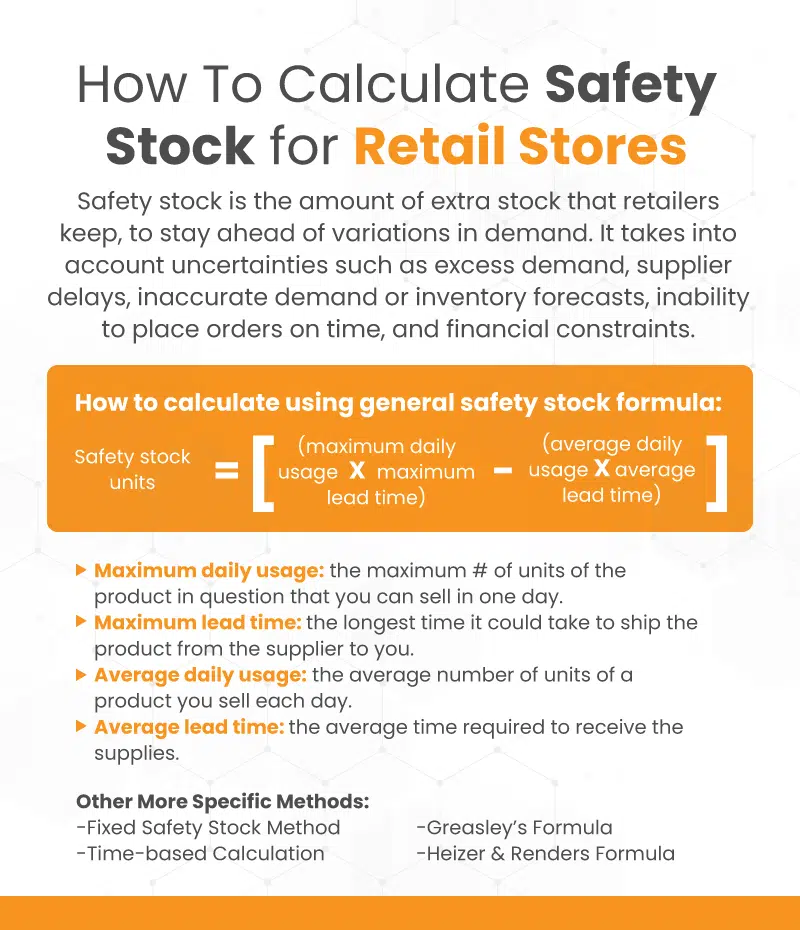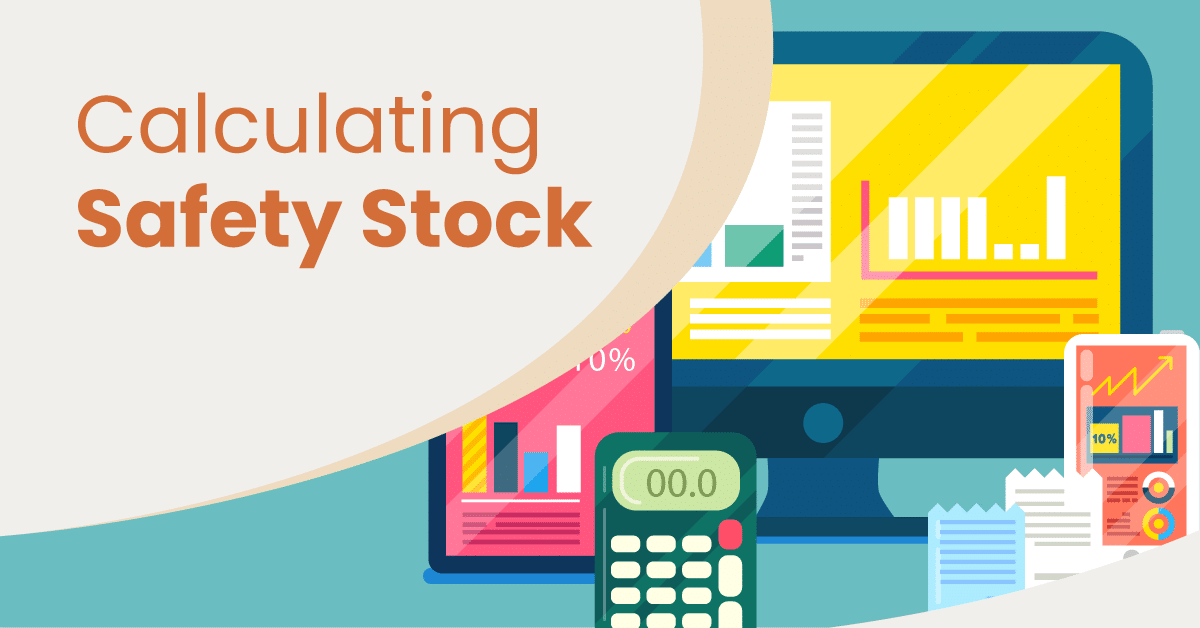
The loss of revenue due to stock-outs is often associated with customers who find the items elsewhere and never return to your business. And even though some stock-outs are inevitable (especially with current supply chain issues), they should be minimized. It is almost impossible to predict how much stock will be needed for a given sales period.
And to avoid any unpleasant situations down the road, safety stock, sometimes called buffer stock, is necessary to maintain a high level of customer service and ensure business continuity. In this article, you will learn what safety stock is, how to calculate it, and factors to consider before calculation. We’ll also walk you through the impact of using inventory management software to calculate it accurately and optimize inventory management.
What Is Safety Stock?
Safety stock refers to the amount of extra stock that retailers keep, which acts as a buffer and insurance against variations in demand. Safety stock takes into account uncertainties such as excess demand, supplier delays, inaccurate demand or inventory forecasts, inability to place orders on time, and financial constraints. Such a stock mitigates the risks and consequences of stockouts, allowing your supply chain to continue, even after the cyclical stock is depleted.
Check out the resources below to learn more about retail inventory management:
- The Ultimate Guide to Inventory Planning: Benefits, Models, Challenges, And Best Practices
- Stockroom Management: How to Organize a Retail Stockroom
- Assortment Planning In Retail: How To Optimize Your Stocks For Your Store’s Profitability?
- How to Run an ABC Analysis: Find Your Top (and Worst) Performing Inventory
- Physical Inventory Count – 8 Ways Retailers Can Improve Their Inventory Counting
Why Is Safety Stock Important For Retailers?
Effective inventory management depends on the margin of safety provided by your backup stock. Accurately tracking current inventory levels while taking into account current and future market conditions and lead times is just the beginning of effective inventory control. Safety stock ensures that you always have what you need to sell.
A 2020 study of North American retail found that products not available on store shelves caused consumers to shop elsewhere, resulting in a loss of $71.4 billion to the retailer. Businesses should have safety stock on hand for several reasons, and it can quickly prove its value in the event of an unforeseen event. The main reasons for having this extra inventory are outlined below:
Prevention of stock-outs
Safety stock allows companies to reduce the risk of a product’s total outage and avoid downtime while the company locates, purchases and delivers that stock. This process can take days or weeks, making safety stock an invaluable bridge that allows the company to continue operating while resolving the stockout.
See also: How to Avoid Product Stockouts for Your Retail Store
Address forecast inaccuracies
Having an appropriate safety stock ensures consistency and allows decision-makers to develop more accurate predictions across the organization. While demand forecasts are generally reliable, sudden changes can make them inaccurate.
The repercussions of stockouts spill over into other forecasts, such as supply chain and staff planning. These problems are particularly troubling when stockouts result in lost revenue or customers, as sales and additional financial forecasts become inaccurate.
Protects against unexpected market fluctuations
Unpredicted fluctuations in market dynamics due to shortages of certain raw materials, increases in oil prices, and changes in government regulations may incur higher than usual costs. As a result, retailers may have to pay more to order new product inventory from manufacturers or to increase freight deliveries from suppliers. Even worse, some products may simply be unavailable.
Safety stock will protect you from purchasing inventory at less favorable, inflated prices in such situations. Of course, you can’t just order an arbitrary amount of stock “just in case”. You need to know how to calculate safety stock to have enough to meet demand without going overboard and incurring overstock costs.
Ensure customer satisfaction
Safety stock is one of the best ways to maintain customer satisfaction and loyalty. If customers can rely on a company that always has what they need in stock, they will not only return but will likely provide valuable word-of-mouth advertising as well. This smart piece of retail marketing strategy pays off big in the long run and helps your business grow.

How To Calculate Safety Stock?
Retailers use several safety stock equations to calculate the right safety stock level based on their inventory mix. The safety stock formula allows retailers to determine an optimal amount of safety stock. However, it is essential to remember that this approach may not be the most accurate, but it is a cost-effective option for small retailers.
Before performing the safety stock calculation, retailers need to know their suppliers’ lead times and how long it takes from when they place an order to when it arrives in their warehouse. Below is the formula for safety stock and determining how many extra units you need to have on hand just in case:
Safety stock general formula
Safety stock units = (maximum daily usage * maximum lead time) – (average daily usage * average lead time).
- Maximum daily usage: the maximum number of units of the product in question that you can sell in one day. Historical data from your point of sale system can help you determine this. If you are just starting, look at the daily sales of the item, then add a buffer for safety.
- Maximum lead time: the longest time it could take to ship that product from the supplier to you. Look at past data to find the longest time it took for that supplier to fill an order and deliver it to you.
- Average daily usage: the average number of units of a product you sell each day. You can also find this number in your store reports.
Average lead time: the average time required to receive the supplies.
Fixed safety stock method
The fixed safety stock method is a method that production planners use. Fixed safety stock calculates the amount of safety stock to be kept from the maximum daily usage over a given period of time, but without using any particular formula.
The value of fixed safety stock usually remains unchanged unless the production planner changes it. Fixed safety stock levels can even be set to zero for items you want to phase out. If there is an unexpected increase in demand for a product with limited safety stock, the company may not be able to meet its commitments.
Time-based calculation
In the time-based method, the safety stock is calculated over a period of time-based on the demand forecast for the product supply. This method involves a combination of actual and forecast demand. The time-based approach cannot consider business uncertainties. Therefore, excessive inventory is risky if the forecast exceeds the demand.
Greasley’s formula
Greasley’s formula considers both lead time and fluctuations in demand, which is a more accurate way to calculate safety stock. But it does not take into account inventory that is still in production and not yet ready to be sold. Using Greasley’s formula, safety stock is calculated by multiplying the average demand (Davg) (average demand is the total quantity of an item required each day over a fixed period of time) with the desired service factor (Z-score) and the standard deviation of lead time (𝜎𝐿𝑇).
Safety stock = Z x Davg x σLT
Heizer & Renders formula
Heizer & Render’s formula is perfect when there is significant fluctuation in supply from your supplier. It uses the standard deviation of the delivery time distribution, which gives you a more accurate idea of your lead times and how often you face very late deliveries. But the formula Heizer & Render’s doesn’t take into account variations in demand.
Safety stock = Z x σdLT
How To Choose The Right Safety Stock Formula
The right safety stock formula depends on several factors, including the following:
- The rate of inventory turnover
- Current and projected product demand
- Current and projected sales volume of the product
- Supplier lead times
The basic safety stock formula is a good starting point for most companies, as it provides a valid rough estimate when the details of the above variables are unknown. For companies with a better idea of the details of these inventories, the more complex formulas are more useful in determining safety stock levels.
Safety Stock Calculation Example
Let’s illustrate the safety stock formula with an example calculation. Let’s say you run a women’s swimwear store. Summer is just around the corner, and you want to ensure you have enough safety stock of bikinis, one of your best-selling products, to meet the demand for this favorite seasonal product. To begin, you need to determine your maximum daily usage, so you look at sales reports from the past three summers. Looking at this data, you see that the most bikinis you’ve ever sold in one day are 20.
Maximum daily usage = 20 bikinis
Next, you need to identify your maximum lead time. You review the inventory logs from the past few years and find that two summers ago, due to the global supply chain crisis, you had to wait three weeks to receive a new shipment of bikinis from your supplier.
Maximum delivery time = 21 days
When you review your bikini sales data, you see that you sell five bikinis on average.
Average daily usage = 5 bikinis
And by reviewing your inventory logs, you see that a new shipment of bikinis typically takes 10 days to arrive.
Average delivery time = 10 days.
Now let’s enter these numbers into the safety stock formula.
Safety Stock Units = (Maximum Daily Usage * Maximum Lead Time) – (Average Daily Usage * Average Lead Time)
Safety stock units = (20*21) – (5*10) = 420 – 50 = 370
According to the calculation, you need to keep an additional 370 bikinis in stock to avoid a stockout due to shipping delays or an unexpected sales increase.

Learn how to manage your inventory effectively with this free eGuide.
Streamline Your Safety Stock With Your Retail Inventory Management Software
Keeping track of inventory, ordering new stock at the right time, and ensuring you always have extra stock on hand is a challenging aspects of running a retail business. With inventory management software, however, you can manage inventory more efficiently. It lets you know what you have in stock at any given time, which products are selling best, and which are not selling well. This allows you to determine your customers’ preferences and plan your orders accordingly.
KORONA POS retail inventory management software allows you to track stock levels and SKUs across multiple locations, whether in your store, at home, or on the road.
An inventory system can also alert you when it is time to order new stock. After calculating and setting a replenishment point, you can receive automatic notifications when your inventory is depleted and you need to replenish it to avoid a stockout.
You can also learn how barcodes work in the stock management ecosystem.
You can order directly from your point of sale system with built-in purchase orders and integrated supplier catalogs. You can even manage purchases from multiple vendors and for multiple locations with KORONA POS master orders.
Inventory systems also give you access to powerful data to help you make informed business and purchasing decisions. For example, the data needed to calculate safety stock, such as average daily usage, or maximum and average lead times, can only be obtained from your POS software sales history data.
See also: What Is Suggestive Selling?
In addition, you can customize the reorder points so that you always know when you need to restock. You can also use the negative inventory reports to keep track of the items you need to replenish the safety stock. For better inventory management, try KORONA POS, an inventory management software designed specifically for retail stores. If you want to learn more about KORONA, click on the button below for a demo with one of our product specialists.
FAQs: Safety Stock
Safety stock requirements are specific to the retailer, the company, and the service level expectations. Establishing a good safety stock level is mainly done by calculating the sales demand and delivery times.
Minimum stock is the minimum quantity of each product the warehouse must have to meet demand. On the other hand, the safety stock, also called buffer stock, is the quantity of stock that a company needs to avoid stock-outs in case of an unexpected increase in demand or any other unforeseen event that could disrupt the supply chain.
Safety stock is an additional quantity of a product stored in the warehouse to avoid a stockout. It serves as insurance against fluctuations in demand.
Let’s assume that a retail company has a team studying market demand and has estimated that the demand for bathing suits is close to one thousand units per month. As a precaution, the company may keep a safety stock of 100 units since demand is never constant.













